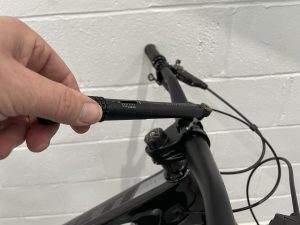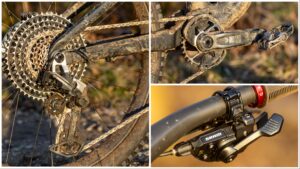Stevens Glide SX review
It’s unlikely that you will have heard of Stevens bikes before now, but it’s a huge German brand based in Hamburg. It has three suspension platforms, where the mid-travel 140mm Glide is flanked by the 160mm Ridge and 100mm Fluent.
Frame
Regardless of travel, all three designs share a similar frame layout, with hydroformed top and down tubes combined with a classic rocker link four-bar suspension rear end. To increase stiffness, the rocker link is a one-piece unit and sports a sag indicator to help with suspension set-up.
The uninterrupted seat tube means you can drop the saddle all the way down on steeper descents and there are blanked-out guides on the underside of the top tube for fitting a dropper post remote.
Cable routing is under the down tube and all of them rub on the fork crown or tapered head tube. Thankfully all three cables have rubber boots to prevent them from eating into the aluminium.
The Glide SX is only available in three sizes, so if you’re particularly tall, or short, you can stop reading now.
Suspension
On the surface there’s little separating the fixed-travel Fox 32 Float fork from the Talas unit on the Canyon. Internally, however, the dampers and spring curves are very different. The basic Float RL model on the Glide SX has a more progressive air spring for better end stroke support, but lacks the low-speed control and sensitivity of the FIT-damped fork on the Canyon.
With a custom-tuned RP2 shock, the rear suspension of the Glide SX is on a level playing field with the Canyon.
Wheels
With 24 spokes front and rear, the Easton XC wheelset is the second lightest on test. However, the 2.25in Nobby Nic tyres are just about on the size limit for the narrow 17c internal rim width. With Schwalbe’s harder Pacestar compound front and rear you’ll be on the limit of traction before you know it, too. Wafer-thin inner tubes reduce rotational weight further, but it’s the fastest route to pinch flats.
Drivetrain
There’s no knocking the performance of the 3×10 Shimano transmission and while the SLX cranks lack the bling factor of XT, there’s hardly anything between them in terms of weight, stiffness and shifting.
Components
While the 700mm Oxygen bar has adequate width, it lacks sufficient upsweep; forcing you to roll the bar forward to get it to feel right and effectively increasing the stem length from 80mm to 90mm. Also, due to the 25mm headset bearing cover, you only get a miserly 10mm of stem height adjustment.
Performance
Swapping the handlebar, stem and tyres for our control components unlocked the Glide SX’s true potential. The geometry and riding position are on the money and while the fork lacks the sophistication of the more expensive Fox units, it’s very much in harmony with the rear suspension — striking a good balance somewhere between the plushness of the Canyon and responsiveness of the Rose.
Hammering down Mountain Ash, we noticed the rear end flexing under hard cornering and off-camber G-outs, but we’re not sure if it’s in the frame or the 24-spoke Easton rear wheel. It could also be the 2.25in tyres squirming on the narrow XC rims.
Technical climbs unearthed some pedal feedback in the granny ring and the pedalling action is noticeably more neutral grunting it out in the middle ring. Still, on fast, flowing trails the Stevens has probably the most balanced handling of any bike in this test. On its very first outing, in hideously slippery conditions, it certainly proved that.
>>> Click here to find out more about geometry with our handy guide
Verdict
There’s no disputing the ride quality of the Glide SX, where the geometry and fit are marginally better than the Canyon and the suspension response feels both balanced and capable. The Glide SX doesn’t feel as solid as the Canyon or Rose, so it would suit lighter riders best, but it’s a decent bike and one that we’d be more than happy to ride — we’re just not convinced that the savings and spec offered by Stevens are good enough to tempt riders away from the high-street brands.
Mbr rating: 8

The Jamis Dakar 650b Comp was tested head-to-head against the Canyon Nerve AM 8.0X, Rose Granite Chief 6 and Jamis Dakar 650b Comp in the July 2012 issue of MBR.















